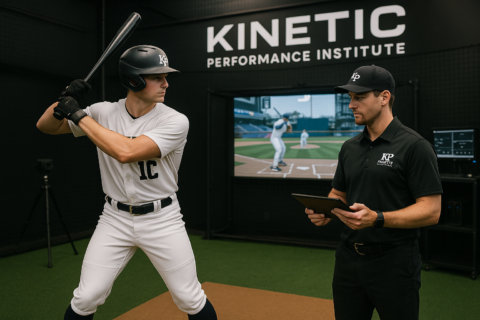Developing Hitting Skills That Scale: Winter 2021/2022 Trends
We train hundreds of hitters at KPI, ranging from the 10 year old youth to the 24 year old professional. Given these wide variances, our recent focus has been on organizing data in a way that we can look for trends and patterns. As we have compiled this statistical approach, we have seen some strong indications on what high level high school hitters look like from an objective lens. To display some of the strongest trends we discovered, we grouped the 10 strongest hitters and the 10 weakest hitters and we averaged out some metrics across each population to display the differences. We used our internal ranking, the KPI Code, to group the hitters. This analysis was done to display trends, not to disparage the lower level group (we did not include names in this). While some of these trends might seem obvious, it is still a valuable exercise to quantify them and our hope is that this will motivate the young athletes at KPI to go for these numbers because we know it will elevate their performance.
Definitions
- Body Weight – Weight of the athletes
- Exit Velocity – Velocity in Miles Per Hour (mph) after contact
- RP (Relative Propulsive Force) – The ability of an athlete to transfer the provided force up the kinetic chain
- BRFD (Braking Rate of Force Development) – The amount of force applied to the ground while bracing for a Counter Movement Jump
The Results
Top 10 Hitters (Average across all of the top hitters)
- Body Weight – 179 lbs
- Exit Velocity AVG – 80.7 mph
- Max Exit Velocity – 97.9mph
- RP AVG – 208.4
- RP Max – 226.8
- BRFD AVG – 7,254
- BRFD Max – 10,847
Bottom 10 Hitters (Average across all of the bottom hitters)
- Body Weight – 117 lbs
- Exit Velocity AVG – 62.6 mph
- Max Exit Velocity – 73.8mph
- RP AVG – 183.8
- RP Max – 204.9
- BRFD AVG – 3,026
- BRFD Max – 5,350
Analysis
There are obvious, and not so obvious, takeaways from the data we outlined above. First, quite simply, bigger and stronger athletes are generally better than smaller and weaker ones. The goal for almost every middle or high school athlete that enters our program should be to gain size and strength while improving skills. It is one of the strongest trends and correlations we have observed with this population.
The next set of data is Exit Velocity. Batted ball data is most closely tracked at the professional and collegiate levels, as well as the very few high tech facilities around the country like KPI. There is not a metric more strongly correlated with offensive, in-game performance than Exit Velocity. The harder an individual hitter strikes the baseball, regardless of swing quality, the better offensive output they will have in games. Of course we want to improve their swing quality, which we do with our amazing hitting system and staff, but we do need to prioritize and emphasize Exit Velocity because we know it will usually create the largest gains in offensive performance for a young hitter. We see similar results with the in-house groups we studied here… the top 10 hitters in our program have much higher Exit Velocities than our bottom 10. Much of this can be attributed to their larger size, but a good amount of it can also be attributed to the strength metrics we have outlined below.
We use force plates to guide our Strength and Conditioning program for the athletes at KPI. We monitor a grouping of metrics with our force plates, but two measurements we pay particularly close attention to with our younger population is Braking Rate of Force Development (BRFD) and Relative Propulsive Force (BR). The vast majority of our younger hitters’ lifting program falls into one of those two categories… and for good reason. This trend report displays that the higher level hitters produce much more ground force and can transfer that force up their kinetic chain much better than the bottom group. This is another trend that seems fairly obvious, but the ability to identify and train it is what separates our program from others.
Conclusion
Young athletes should be seeking out development programs that have a structured/individualized approach and ones that dive into the data like this. If this is not the approach, then young athletes and their families are just trusting that the lesson or teams coach knows what he or she is doing, along with in-game performance. Both of those dynamics are very subjective and inevitably feed the current system most participate in, which has an extraordinarily high failure rate. At KPI we are flipping the script on the normal and showing our work while proving our approach leads to success. This should be the standard, not the aberration… Are You Ready?
““


